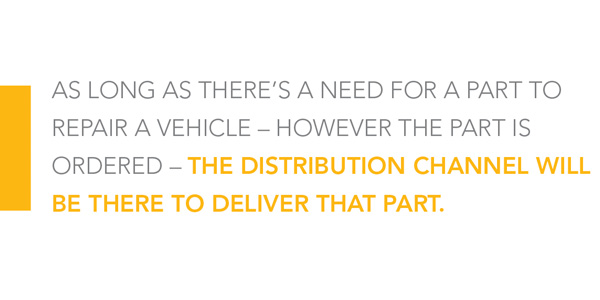
In a recent report on aftermarket parts sales, Hedges & Co. predicts that online retail sales of auto parts and accessories in 2018 will exceed $10 billion for the first time, marking a 16.3-percent increase over 2017. More than $5 billion of that will take place on mobile phones.
Hedges & Co. also forecasts that online sales of auto parts will climb to nearly $16 billion in 2021.
The digital marketing agency predicts that online activity will have an influence on nearly $152 billion in parts and accessory sales through all retail channels – chain retail stores, automobile dealers, big-box retailers, independent brick-and-mortar retailers, jobbers and online sales – by 2021.
On the surface, these figures could be alarming. However, if you take a closer look, they’re probably in line with what you would expect.
The forecast doesn’t predict that all parts sales are going to the internet, and it doesn’t say that all brick-and-mortar locations are going to disappear. But it indicates that there’s a shift in buying habits, due to the availability and adoption of new technology.
While $10 billion sounds like a big number, it’s still a small percentage in terms of the overall aftermarket. The Auto Care Association’s Auto Care Factbook estimates DIFM parts sales at $109 billion and DIY parts sales at $57 billion.
Also, remember that the $10 billion number includes parts and accessories. For years, accessories have been sold through different channels, so this component really shouldn’t be surprising. However the order is created, it still will ship from a location – and today that distribution system is the aftermarket. Even one of the largest online parts sellers uses the traditional aftermarket to fulfill. It’s just hidden behind the curtain.

As far as influence, of course online is influencing the sales. The internet is a real thing and people are going to use it. Probably a bigger contributor is the population’s adoption of smart devices – this is what really gives them access to the information. The reality of this connection is it provides/requires pricing transparency. This will affect distribution channels, but in the end, orders will need an entity to fulfill them.
Along with all of this, let’s not lose sight of the fact that the sale of most parts today
requires knowledge of the operation and application of the parts. Yes, cataloging has come a long way. But it still doesn’t have artificial intelligence. Repair professionals, DIYers and the entire channel depend on the distribution system to provide this service.
Here’s my point: Sure, the internet and technology are distractions (and in some cases interruptions), but the automotive aftermarket exists because it has always been nimble and solution-driven. As long as there’s a need for a part to repair a vehicle – however the part is ordered – the distribution channel will be there to deliver that part.







